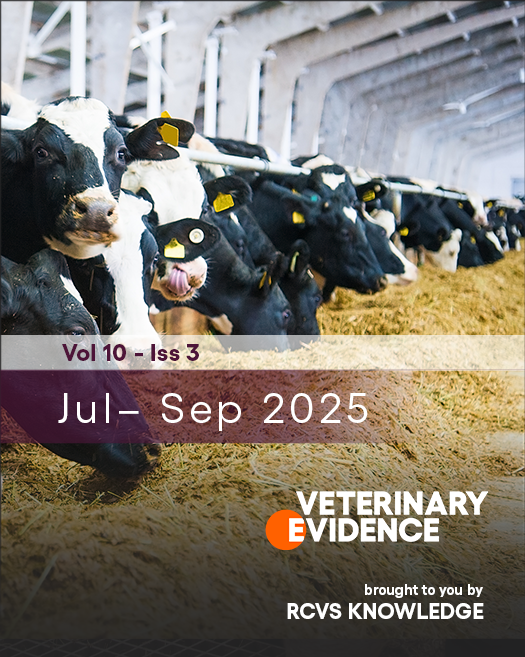DOI
https://doi.org/10.18849/ve.v10i3.47Abstract
PICO Question
In dogs and cats does the changing of IV fluids every 96 hours, compared to longer durations, reduce the risk of contamination in the bag?
Clinical bottom line
Category of research
Incidence.
Number and type of study designs reviewed
Two prospective studies and a Cochrane systematic review for human patients.
Strength of evidence
Weak.
Outcomes reported
There was some consistency between the human systematic review and clinical experimental design in the veterinary intensive care unit (ICU). Another experimental study created some heterogeneity in results, where fluids were not contaminated for a long time (60 days), but two factors limit this study’s external validity, it was conducted in a clean laboratory environment and ports were wiped with alcohol before culturing samples. Both veterinary studies are limited as they only explored intravenous (IV) fluid bags which had no additives and were not connected to live animals or IV sets.
Conclusion
Based on two prospective veterinary experiments and one human Systematic Review (meta-analysis), fluid bags and IV sets should be changed every 72–96 hours. Additionally, supportive evidence suggests that environmental cleanliness and creating a routine of wiping ports with alcohol prior to injection or withdrawal may significantly decrease the likelihood of fluid contamination. This certainly seems to be an area that needs more experimental studies with a low risk of bias on clinical patients.
References
CDC. (2011). Background Information: Strategies for Prevention of Catheter-Related Infections in Adult and Pediatric Patients, [online]. Available at: https://www.cdc.gov/infection-control/hcp/intravascular-catheter-related-infection/prevention-strategies.html [Accessed: day/month/year].
Fausak, E. D., Spelts, S. R., & Brown, R. L. (2016). Can I Hang? Ideal Time to Replace Isotonic Crystalloid Intravenous Fluids and Sets to Prevent Fluid Contamination and Blood Stream Infection: a Knowledge Summary. Veterinary Evidence. 1(4). DOI: https://doi.org/10.18849/ve.v1i4.47
Guillaumin, J., Olp, N.M., Magnusson, K.D., Butler, A.L & Daniels, J.B. (2013). Influence of Hang Time on Bacterial Colonization of Intravenous Bags in a Veterinary Emergency and Critical Care Setting (abst). Journal of Veterinary Emergency and Critical Care. 23, S6. DOI: https://doi.org/10.1111/vec.12088
Guillaumin, J., Olp, N.M., Magnusson, K.D., Butler, A.L. & Daniels, J.B. (2017). Influence of hang time and location on bacterial contamination of intravenous bags in a veterinary emergency and critical care setting. Journal of Veterinary Emergency and Critical Care. 27(5), 548–554. DOI: https://doi.org/10.1111/vec.12647
Matthews, K.A. & Taylor, D.K. (2011). Assessment of Sterility in Fluid Bags Maintained for Chronic Use. Journal of the American Association for Laboratory Animal Science. 50(5), 708–712.
Sabino, C.V. & Weese, J.S. (2006). Contamination of multiple-dose vials in a veterinary hospital. The Canadian Veterinary Journal. 47(8), 779.
Ullman, A.J., Cooke, M.L., Gillies, D., Marsh, N., Daud, A., McGrail, M.R., O’Riordan, E. & Rickard, C.M. (2013). Optimal timing for intravascular administration set replacement. Cochrane Database of Systematic Reviews. 9, CD003588. DOI: https://www.cochranelibrary.com/cdsr/doi/10.1002/14651858.CD003588.pub3/full
License
Copyright (c) 2025 Erik Davis Fausak, Samantha Rae Spelts, Rebecca Lee Brown

This work is licensed under a Creative Commons Attribution 4.0 International License.
Veterinary Evidence uses the Creative Commons copyright Creative Commons Attribution 4.0 International License. That means users are free to copy and redistribute the material in any medium or format. Remix, transform, and build upon the material for any purpose, even commercially - with the appropriate citation.
Most read articles by the same author(s)
- Erik Fausak, Elizabeth Rodriguez, Anna Elizabeth Simle, Netwarat Merman, Dakota Cook, Does the Use of Intratesticular Blocks in Cats Undergoing Orchiectomies Serve as an Effective Adjunctive Analgesic? , Veterinary Evidence: Vol. 3 No. 4 (2018): The fourth issue of 2018
- Erik Fausak, Melissa C. Funaro, Andrea C. Kepsel, Erin R.B. Eldermire, Margaret Foster, Hannah F. Norton, Kim Mears, Molly E. Crews, Marnie Brennan, Gillian L. Currie, Megan R. LaFollette, Annette O’Connor, Adrian J. Smith, Kimberley E. Wever, Suzanne Fricke, Systematic reviews of animal studies – Report of an international symposium , Veterinary Evidence: Vol. 8 No. 3 (2023): The third issue of 2023
- Laura Shultz, Erik Fausak, Borrelia burgdorferi exposure in coyotes: an indicator of B. burgdorferi levels in urban versus rural environments , Veterinary Evidence: Vol. 7 No. 1 (2022): The first issue of 2022
